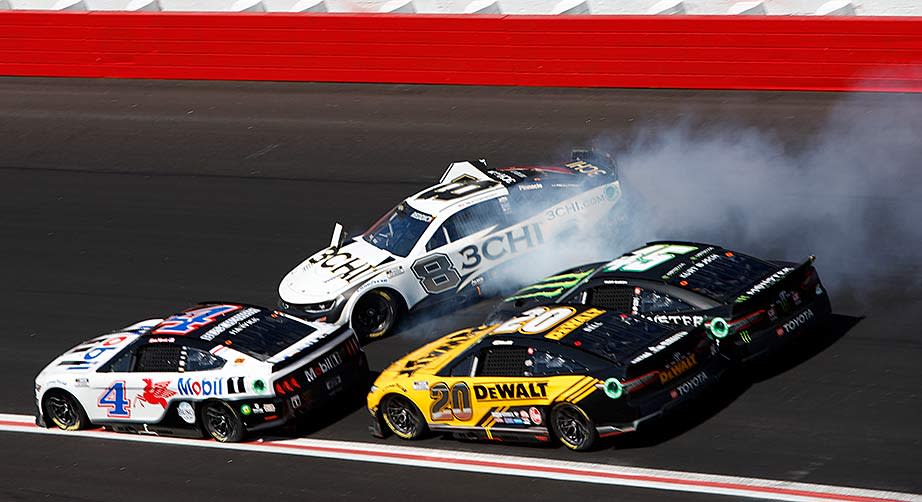New-look Atlanta's superspeedway revival one for the ages
HAMPTON, Ga. — Marcus Smith stood in the corner of the Atlanta Motor Speedway media center watching the laps of Sunday’s 500-miler tick down into the single digits, a slight, wry smile on his face. His Speedway Motorsports team had been tasked with bringing a superspeedway into the corporate portfolio, and by golly, they had done it — without merger or acquisition, without a ground-up construction project.
Instead, they DIY-ed this beast at one of its own existing tracks, taking the superspeedway formula popular at 2.5-mile Daytona and 2.66-mile Talladega, shrinking it in the dryer and applying it to a 1.54-mile hybrid in Atlanta. Hence one of the reasons for Smith, the company’s CEO and president, to ever-so-slightly beam in the closing laps. The better-than-average crowd on a cool, sunny Sunday offered yet another excuse to grin.
RELATED: Cup Series standings | At-track photos: Atlanta
Atlanta Motor Speedway had hosted 115 NASCAR Cup Series races before this one, but none had quite the same look and feel. In past lives, an Atlanta race was grueling for its speed, in some years the central Georgia heat, and its tendency toward tire wear. Now, it’s a taxing venue for the white-knuckle, pack-racing style of competition that used to happen just four times a year. Now it’s up to a half-dozen.
So how was it? That answer probably depends on where you line up on superspeedway racing, whether you circle the calendar dates for Daytona and Talladega in red pen, or whether your preferences lie elsewhere. Either way, a pair of last-lap passes decided the weekend’s other NASCAR national-series events, and it’s hard to argue with the gate, which added up to one of the better-attended Atlanta races in recent memory.

The stats were staggeringly new as well. Twenty of the 37 starters led laps, and the list of the record 46 lead changes was as long as your arm. Crash involvement ran higher than normal, too, with little place to hide once things went awry in the bunched-up draft. Kurt Busch won the last race on the old Atlanta surface last year by 1.237 seconds. Sunday, he was among the top 14 finishers who crossed the start/finish line within that margin behind race winner William Byron. Many of the regular contenders in this style of racing rose to the top again — Byron, Denny Hamlin and Bubba Wallace among them. Luck is involved, sure, but there’s also a skillset to it.
Whether that all fits the definition of a competitive race also all depends on your fondness for superspeedway racing.
“It‘s a regular superspeedway. We just keep crashing,” said Joey Logano, who rallied from a mid-race incident to finish ninth. “… We survived, but a lot of cars crashed today for sure, just like we would expect. I don‘t know, you be the judge if it was entertaining or not. It‘s a different type of racing.”
Georgia native Chase Elliott started and finished sixth after the frantic 500 miles. “It was crazy, for sure,” he said. “Hopefully it was fun to watch because I felt like it was wild from my seat.”
Atlanta’s first two versions came during two separate periods of speedway boom times. The track initially sprang to life as a hulking 1.5-mile true oval in 1960, as stock-car racing had just started its slow gravitation away from small fairgrounds facilities and dirt tracks. The next iteration came in 1997 when Speedway Motorsports put its stamp on the place with the doglegged frontstretch that it also uses in Charlotte and Texas. Around the same time, other intermediate-sized tracks were sprouting in places across the country, some built without a promise but on the mere hope of attracting NASCAR’s national series.
This rendition of Atlanta comes during a time period where anything on the schedule seems possible. The Cup Series opened the year with an exhibition on a special-order quarter-mile track inside the LA Coliseum, and the premier division will return to a dirt vision of Bristol Motor Speedway for the second straight year. Team owner Rick Hendrick mentioned his appetite for bringing the seventh-generation Cup Series car to a street circuit during his post-race media appearance. New facilities, an influx of road courses, wide-open possibilities — it’s all there.
Still, just because you can do something doesn’t mean you necessarily should. Atlanta direly needed new pavement to replace its worn-out and patched-up surface. It also needed a side dose of pizzazz, something that allowed it to keep up with that spirit of change. Brothers and sisters, we got that and then some.
MORE: Byron bags first win of 2022 | Atlanta’s reconfiguration in photos
While the new-look Atlanta debut checked plenty of boxes in terms of what went right, let’s let the paving crews and heavy machinery cool off a bit before hurrying to reimagine other intermediate-sized tracks that need the same superspeedway spice.
As entertaining as Sunday’s race was — again, depending on your viewpoint — the NASCAR industry cannot do this every week. Our collective hearts can’t take it, and besides the potential for burnout, the toll in damaged machinery typically runs high at superspeedway events. Hendrick, who prevailed Sunday but has a vested interest in the crash-damage bill, suggested that capping superspeedway races at the current six would help ease some of those ills.
At the other end of the Atlanta media center from where Smith stood, there’s a display case full of diecast cars. The collection spans all previous six generations of Cup Series models, illustrating just how long the track has stood and how cars have evolved during its lifespan.
There’s room there for a miniaturized version of Byron’s winning Next Gen No. 24 Chevrolet to commemorate Sunday’s thriller, serving as a marker for Atlanta’s superspeedway revival and the next era for both car and track.

